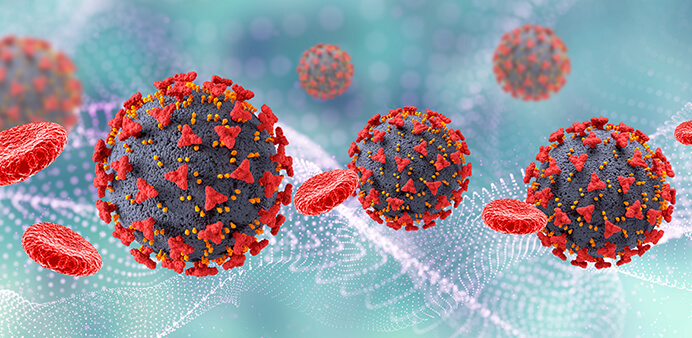
“Omicron sub-variant BA.2 has skyrocketed Covid-19 cases, with scientists from Imperial College London, stating that the virus is more prevalent in England than at any time during the pandemic” [1]
Now that free testing across England has been brought to an abrupt end, & the rest of the UK will follow suit in a matter of weeks, infection levels have reached a record high in the UK, with close to 5 million people thought to be infected [2]. To that end, people have been left to fend for themselves, as the NHS have added these new symptoms in the hope that they will reduce the spread of coronavirus, & help those who don’t have immediate access to a test. – But as millions of people would point out, surely, we still need to have tests…
So What Are the New COVID-19 Symptoms?
These nine symptoms which have been added by the NHS, comprise:
An Unnecessary Long Delay?
Professor Spector, tweeted: “NHS Official Main Symptoms of Coronavirus (COVID-19) have finally changed after 2 years of lobbying & Zoe app user input – hurrah! Pity they have the order wrong – but it’s a start & could help reduce infections. Thanks ZOE loggers!” [2]
It seems strange that it has taken two long pandemic-ridden years for the aforementioned signs of COVID-19, to be finally been acknowledged by the NHS. After all, the World Health Organisation (WHO), the United State’s Centres for Disease Control and Prevention (CDC), and other international bodies, have publicised substantially longer symptom lists for a long time. – As has the Zoe COVID-19 symptom tracker app [2].
So finally, the NHS website has added these nine symptoms to the three conventional symptoms which people acquire when they have a fever: a new and continual cough, and a change or loss in the way we smell and taste things. Professor Chris Whitty, the UK government’s Chief Medical Officer, is thought to have given the go-ahead for this new development. And now that the general public have a broader overview of COVID-19 symptoms, it should help everyone be more mindful about the need to get their own test when they recognise one or more of the symptoms on the updated list. Not to mention companies regularly testing their employees [2].
And while only the most vulnerable are able to access a free test in England, the good news is that it is not expensive to order an online test from a reputable company. It is always better to be safe than sorry, and knowing that you have COVID-19, and have to isolate from your family, work colleagues, and the public at large, is very important. – As is knowing that you need to monitor your condition to make sure that your symptoms don’t get worse. And this knowledge also enables you to tell your loved ones, just in case you need to get to the hospital quickly. – They can keep in regular touch with you to check on your progress, and be able to make an emergency call, should it be necessary. Or be free to drive you to a hospital, anytime day or night.
PCR Testing
PCR (also known as polymerase chain reaction) testing, is able to detect whether you have specific genetic material (e.g. a virus), at the time of your test. Inline with the UK government’s last testing,
regime, individuals would only be eligible for these types of lab-performed tests – if 1: They had been asked to take a test; or 2: If they were experiencing one of the three key symptoms that were listed by the NHS [2].
Some weeks ago, Professor Spector (who specialises in genetic epidemiology, and directs King’s College London’s TwinsUK registry), expressed his dismay at the government’s “refusal” to acknowledge a “wider array of symptoms” [2]. Indeed, he put forward the case that: “Not acknowledging the wider list of ailments afflicting people with the virus, along with the decision to drop isolation advice and withdraw free testing, could have driven up transmission rates” [2].
How Can I Tell the Difference Between a Common Cold & COVID-19 Symptoms?
The answer to this question, is: “Without a proper COVID-19 test, it’s not so easy,” which is why ordering a high quality test from a reputable online Company, is the best course of action.
Comparing the Symptoms of a Common Cold & COVID-19
“Unfortunately it can be very difficult to tell the difference between Covid & a cold, if you don’t have a test, particularly with the Omicron variant. The Zoe Covid study states: “Many of the symptoms of Covid-19 are now the same as a regular cold, especially for people who have received two doses of the vaccine, making it hard to tell the difference” [1]
Covid-19 Symptoms
Common Cold Symptoms (as per NHS guidelines)
In a Nutshell
The key differences between COVID-19 symptoms, and those of a common cold, are that individuals with COVID-19, can experience diarrhoea, feel sick, and have intense tiredness. Yet while it has to be said that having a cold can also make us feel tired; generally speaking, diarrhoea and feeling sick, are not associated with having a cold.
If I Start Feeling Ill & Think I have COVID, What Should I Do?
While the UK government and the NHS state that you no longer have to self-isolate or take a COVID-19 test, the reality of the massive number of people contracting the virus, dictates that we should use our own best judgement, and in many cases, this will mean staying at home until we have ordered an online test, to ensure that we are in the clear.
NHS Advice For Those Who Have Symptoms or Test Positive
References
[1]. Finnis, A. (2022). “Covid symptoms explained: How to tell the difference between the new NHS signs of coronavirus and a cold.” inews.
[2]. Gillespie, T. (2022). “New COVID symptoms added to official NHS list as free testing ends.” Sky News.
https://news.sky.com/story/covid-19-nine-new-symptoms-added-to-list-as-free-testing-ends-12582079
[3]. Hall, R. (2022). “UK Covid symptoms list expanded with nine more signs of illness
Symptoms including shortness of breath, feeling tired and loss of appetite added to official list.” The Guardian.
Emir Limam – E11 Group B.V. Netherlands – Fraudster
24 May 2023When to Take a Test After Covid Exposure?
30 January 2023A Rapid Antigen Test vs a Lateral Flow Test for Covid-19
30 January 2023